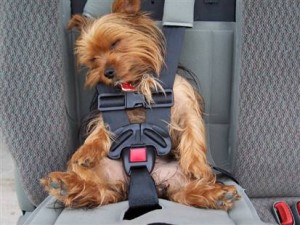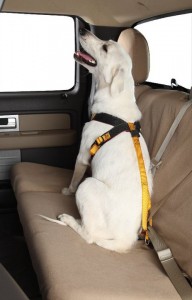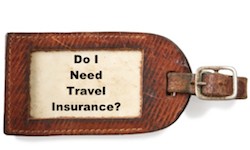Dog Seat Belts Recommended for Holiday Travels
 Although the automotive dog seat belt pictured here doesn’t appear to be a recommended option, it sure looked like a cute photograph for this article.
Although the automotive dog seat belt pictured here doesn’t appear to be a recommended option, it sure looked like a cute photograph for this article.
I was reading through a number of travel related press releases and I found this informative piece that I thought I would share with you.
###
Jenny Pavlovic, engineer and author of The Not Without My Dog Resource and Record Book, said that the most important thing a pet owner can do is restrain pets when traveling in a motor vehicle.
“Restraining pets keeps them from interfering with the driver and keeps them safe in the event of sudden braking or impact,” Pavlovic said.
She also stressed that it is equally important for pets not to travel in the front seat or sit on a passenger’s lap.
 “A pet could get crushed by an air bag or the body of a passenger upon impact if sitting in the front seat or on a lap,” Pavlovic said.
“A pet could get crushed by an air bag or the body of a passenger upon impact if sitting in the front seat or on a lap,” Pavlovic said.
Restraining a pet at all times is generally a good idea for pet owners, especially since the National Highway Traffic Safety Administration reports that more than 1.5 million automobile crashes are caused each year by distracted drivers. But, according to the American Pet Products Association’s 2009-2010 National Pet Owner Survey, 56 percent of respondents said they do not restrain their dog while driving.
Unrestrained pets, just like unrestrained people and items, can pose a serious threat to the driver and other passengers.
According to Pet Safety Lady, Christina Selter, a 60-pound unrestrained dog in a vehicle traveling 35 mph can cause an impact of 2,700 pounds when slamming into a car seat, windshield or passenger.
Secured travel is the best way to ensure safety. Pavlovic believes that a secured travel kennel is the best way to restrain dogs, but a harness that attaches to the seat belt works well for medium to large dogs.
“Restraining pets keeps them from interfering with the driver and keeps them safe in the event of sudden braking or impact”
“The harness should be designed to safely distribute pressure across the dog’s body in a way that will not harm the dog,” Pavlovic said. “Never restrain a dog by the neck while traveling in a moving vehicle, as this could lead to strangulation.”
It’s also important to note that travel can be disorienting and frightening for some pets. Because of this, Pavlovic suggests that pet owners teach their dog to wait when the car or crate door is opened.
“This can be done by offering your pet a treat while you put their leash on,” Pavlovic said. “Do this consistently to get your pet in the habit of waiting and not bolting out of the vehicle.”
Pavlovic also suggested a few proactive measures that pet owners can take before hitting the road:
- While traveling, put a note on your pet’s travel kennel with information about your pet, as well as what to do and who to contact if something happens to you.
- While traveling away from home, use a harness or martingale collar that the dog or cat won’t slip out of.
- Make sure your pet has proper identification, including a collar with ID tags and a microchip that has been properly registered with the microchip company. Make sure the ID tag has a phone number where you can be reached while traveling.
###
From my research, I found the Ruff Rider Roadie® Canine Vehicle Restraint (pictured above left). If you don’t care to fuss with a seat belt for your dog, then Pet Sitters International, the writers of this press release, recommend the services of a professional in-home pet-sitter.
Regardless of your choice, please keep yourself and Fido safe over the holidays!
 The Roaming Boomers
The Roaming Boomers




Do you fall within this category of boomers who love to spend time with their furry family members? I found this statistic on the internet interesting particularly because this trend is on the rise. “55-64 year-olds are the fastest growing age demographic in the pet industry, spending $7.75 billion in 2005, up 127% from 2000. With the active boomer generation set to spend more time with their pets, whether at home or on the road, we expect to see more travel products for pets over the next two years.”